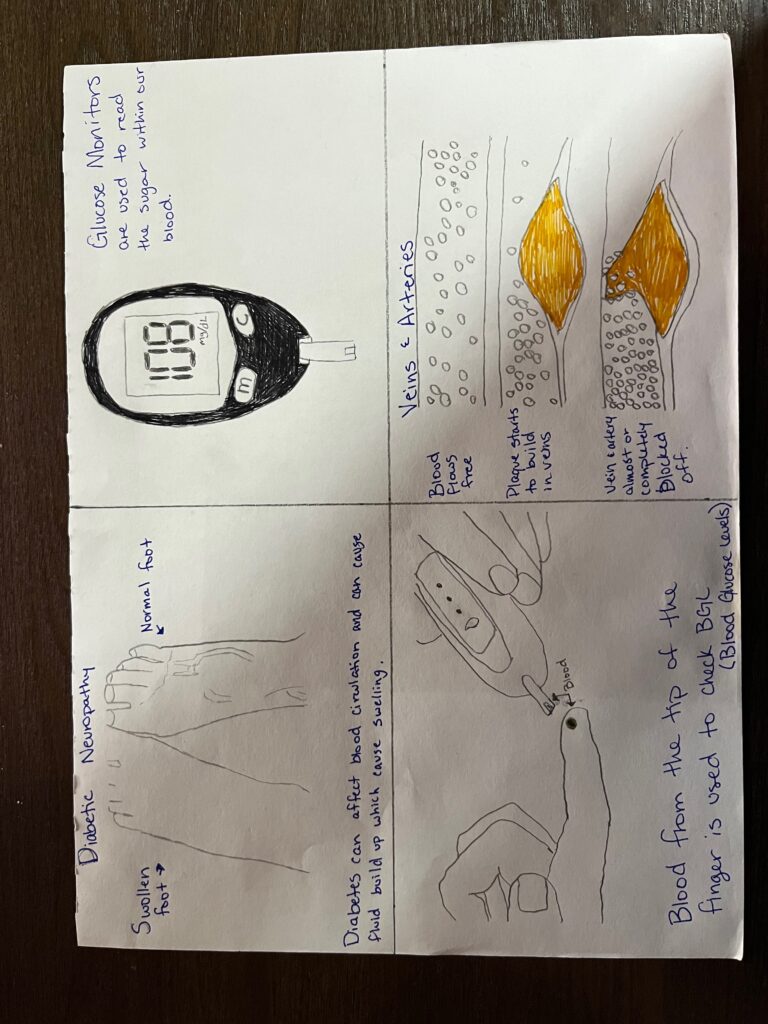This paper is about diabetes. Diabetes is a big part of my family, my grandma had it for years and I took care of her. I learned a lot about diabetes during the time I took care of her. Diabetes from then has been a huge interest in my life. I have done a few other papers on diabetes. This paper is about diabetic neuropathy, the effects diabetes has on the nerves. In this paper I talk about what diabetes is and what different types of diabetes there are. There are three main types of diabetes. Type one, Type two, and gestational. Type one occurs in younger people and type two occurs in older people. These two types of diabetes can come from genetics. Type two diabetes can come from a few different things including obesity. Gestational diabetes is when a pregnant woman gets diabetes because her pancreas is not making as much insulin as two people need. In this case, a mother will most likely have diabetes end after the baby is born. There are some cases where the mother keeps diabetes, and it can stay with the mother for the rest of her life. Gestational diabetes can lead to health risks or conditions in the baby. The baby and mother are more prone to having type two diabetes when they get older. There are four types of neuropathies that occurs with diabetes. There is peripheral neuropathy, autonomic neuropathy, proximal neuropathy, and mononeuropathy. The most common type of neuropathy is peripheral neuropathy. Peripheral neuropathy affects the hands, arms, legs, and feet. With this type of neuropathy, there is a greater chance of infection. All the neuropathies affect the feet, arms, legs, feet, heart, and abdomen. With diabetes, there are a few different things that could happen in the future. There is the chance of a stroke or heart attack. A heart attack happens when arteries are clogged with plaque and the arteries are not pumping enough blood through the heart. With diabetes, there is a higher chance of this because, with high blood sugar, the blood vessels thicken which makes it harder for blood to flow through the vessels or arteries. In this paper, I also talk about different types of insulin used for diabetes. There are five different kinds of insulin. Rapid insulin, Regular insulin, Intermediate-acting insulin, Long-lasting insulin, and Ultra-long-lasting insulin. Each type of insulin has different times in which they act. Rapid insulin is the fastest but not the longest-lasting insulin. Rapid insulin is used primarily before a meal. This insulin helps use the sugars from the food your body is ingesting and turns them into energy. Regular insulin is an insulin that people use during the day. It lasts up to eight hours and is usually used twice a day. The longer-lasting insulin basically explains itself in their names. They all last a long amount of time which is anywhere from eight hours to two days (48 hours). This concludes my paper about diabetic neuropathy.


Abigail Hills STEAM Project Diabetic Neuropathy is about both diabetes and the effects diabetes has on nerves. Abigail starts her writing with the connection she has to the project compelling her readers with ethos. She then goes into listing and describing the different types of diabetes there are type 1 diabetes, type 2 diabetes, and gestational diabetes. Next Abigail lists the different types of neuropathies that occur with diabetes ultimately connecting the two ideas of diabetes and neuropathy. The different types of neuropathies are peripheral neuropathy, autonomic neuropathy, proximal neuropathy, and mononeuropathy. She goes more into detail about peripheral neuropathy because it is the most common but also includes what all of the neuropathies affect. It is harmful for people with diabetes because of the complications that can happen. Lastly, Abigail talks about insulin, the five different types are rapid insulin, regular insulin, intermediate-acting insulin, long-lasting insulin, and ultra-long-lasting insulin. She explains they are all taken at different times then describes when a few of them should be taken. Concluding with an approximation of how long all types of insulin last.